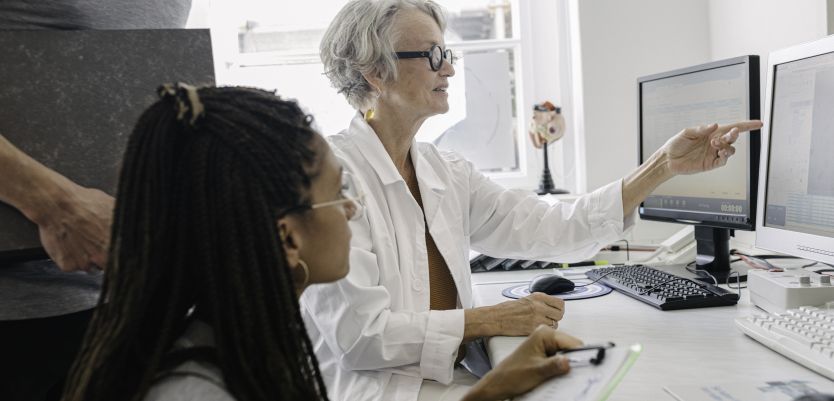医薬品の有効性が期待できる患者さんをバイオマーカー検査により特定できれば、臨床試験の成功の可能性を高め、優れた費用対効果をもたらすことができます。1 FDAは近年、コンパニオン診断薬 (CDx) を伴わない標的オンコロジー医薬品をいくつか承認しました (これらの医薬品には市販後のアッセイ開発が義務付けられています ) が、診断薬が存在しないことは、市場での普及や患者さんの安全性およびアクセスに悪影響を与える可能性があります。2
しかし、患者さんを層別化するためのCDxの開発は、往々にして研究グレードから臨床グレードへの診断薬の移行を治験依頼者に強いることになります。これは多分野にわたるリソース管理を必要とする課題であり、特に新興企業にとって高い障壁となります。したがって、必要な時間とリソースを最小限に抑える最も効率的で負担の少ない規制パスを見極めなければなりません。
5つの効果的な初期段階の薬事戦略
弊社はFDAとの治験前新薬申請 (pre-IND) ミーティングを準備している企業と頻繁に協力しています。これらの企業は、開発中に患者さんを選択するためのCDxが必要になるかもしれないと予想はしているものの、十分なデータを持っていません。
弊社は通常、INDの下でアッセイに関する議論を続けるようクライアントにアドバイスします。第I相または第II相試験で商用CDxの必要性が実証されたら、医療機器・放射線保健センター (CDRH) に治験機器免除 (IDE) を申請しなければならない場合があります。場合によっては、最初からIDEが必要になることもあります。
大限のメリットを引き出して開発プロセスを合理化する5つの戦略を磨き上げてきました。
1. ミーティングごとに明確な目標を設定
治験依頼者は初期のFDAとのやり取りのたびに明確な目標を設定する必要があります。たとえば、第I相試験でなんらかの検査を使用して患者さんを層別化することを計画している場合、pre-INDミーティングには3つの重要な目標があります。
まず、提案した検査の分析的検証が (特にカットオフ値付近において) 十分になされていることについて、FDAの同意を得ます。バイオマーカー陽性者と陰性者をどのように定義すればよいでしょうか。規制当局との確固たる意見の一致がない限り、INDに対して臨床保留通知を受けるリスクがあります。
次に検査機器に対して実施したリスク評価についてFDAの同意を得ます。対象の検査機器がラボ開発検査 (LDT)、市販の体外診断用医薬品 (IVD)、新しいカスタムIVDのいずれであるかは問いません。FDAが治験におけるLDTまたはIVDの使用を21 CFR 812.3(m)に従って「重大なリスク」とみなした場合、CDRHにIDE申請を提出するよう求められる可能性があります。その後、医薬品評価研究センター (CDER) または生物学的評価研究センター (CBER) がCDRHとともに第I相試験を監督します。
最後に、検査の回数とタイミングや結果の使い方など、第I相試験デザインに関する詳細なフィードバックを得ます。
弊社は最近、「検査機器のリスクは十分に低く、第I相試験にCDRHの監督は必要ない」と主張した治験依頼者が、その理由を説明できるよう支援しました。これにはバイオマーカーが治療反応をどのように予測するかなど、バイオマーカーそのものや疾患に対するバイオマーカーの関係についての深い理解が必要でした。弊社は治験依頼者に独自の研究ではなく遺伝的変異体の公開データベースと医学文献検索を使用するようアドバイスし、その結果、治験依頼者の規制上の負担は大幅に軽減されました。
2. 的を絞った質問
FDAの担当者は、治験を自らデザインしたいわけではありません。彼らの仕事は、具体的な意見を述べることです。初期段階のCDx申請ミーティングにおいては、自由回答形式の質問よりも、案を提示して回答を求めるといった方法が望まれます。
FDAの意見が記録された後、それに従わない場合は、その後のFDAとのミーティングややり取りにおいてその理由を説明しなければならない可能性があります。pre-INDミーティングは、多くのマイルストーンの一つにすぎません。やり取りはこのミーティングだけではないため、この段階でFDAが知る必要のある情報のみを伝え、それ以上の情報は与えないよう注意してください。
開発を進める中で、医薬品とCDxの共同開発のストーリーについて考慮してください。プログラムの一部の側面についてまだ計画が確定していないことを明らかにすると、FDAが過度の期待を抱き、それによって負担が増す可能性があります。
最近ある治験依頼者から、pre-INDミーティングの準備を手伝ってほしいという依頼を受けました。同社はCDxが必要かどうかを検討するために第I相試験の実施施設になんらかのアッセイを実施させたいと考えており、FDAに進め方を質問するつもりでした。しかし、FDAとのやり取りから、施設間のばらつきがバイオマーカー検査の一般的な問題であることがわかりました。ある施設は分子検査に次世代シーケンシング (NGS) を用い、別の施設はポリメラーゼ連鎖反応 (PCR) 技術を用いる可能性があります。これらのアッセイの分析的検証のレベルは一定ではありません。FDAはこれらの施設の適格性を評価するためにどのような計画を立てているのかを知ろうとします。また、治験依頼者は十分な分析的検証を実証し、施設間のばらつきを最小限に抑えるために、必要最低限のパフォーマンス要件を確立する必要があります。
企業が十分に詳細な計画を持っていなくても、開発段階の計画は受け入れ可能であるとFDAが結論付けられるものを提示することは可能です。たとえば、上記の治験依頼者の例では、FDAの懸念に未然に対処するため、提示する計画に「すでに分析的検証の優先順位を上げており、次のアッセイ開発段階に必要なデータが十分に得られると考えられる」という記述を追加するよう治験依頼者にアドバイスしました。この概要計画はほとんどコメントなしでFDAに承認され、懸案を解決するために再度FDAとミーティングを開く必要性を回避できました。
3. 状況の適切な判断
治験依頼者は最初に高水準の計画を提示することで、後からFDAによって計画が変更されるリスクを軽減できます。たとえば、ヒューマンファクター (HF) 試験は、アッセイのラベルを医療従事者や検査技師などのユーザーに理解しやすいものにすることでリスクを軽減し、サンプルの調製時に液体を添加しすぎたり、サンプルのインキュベート時間が長すぎるといった起こりやすいミスを適切に防止します。
多くの場合、治験依頼者は HF 試験のデザインと実施に専門会社を利用します。これには費用と時間がかかります。試験のデザインを専門会社に依頼し、事後にFDAから試験の批評を受けるのではなく、まずHF試験デザインの大まかな概要をFDAに提示します。そこから余計なフィードバックや要求事項が導き出されないようにするため、計画は厳密で問題点を指摘されないようなものとし、回避すべき課題の範囲を明確に定義します。その後、FDAの審査員に推奨事項を補足してもらいます。同時に審査員の反応とボディランゲージを評価し (ミーティングが対面またはビデオミーティングの場合)、審査員からの質問を書き留めます。
このような情報があれば、HF会社にFDAのフィードバックに基づいてプロトコルを作成するよう依頼することができ、計画再検討のリスクが大幅に低減します。
4. 緊急時の対応計画を策定
弊社は最近、ある大手製薬会社が厳しい期限内にIND申請を完了できるよう支援しました。同社は患者さんを選択して層別化するために第I相試験で社内アッセイを使用することを計画していましたが、CDRHにIDEを提出する必要があるとは考えていませんでした。しかし、治験での当該アッセイの使い方を根拠にFDAが同意しない可能性があることは認識していました。その一方で、第I相の最初の治験参加者登録 (FPI) の期限が迫っており、規制当局が同社のアプローチを承認するまで待つことはできず、IDE申請書を作成する時間も残されていませんでした。FDAによるINDの審査中に、私たちは必要に応じて提出できるように完全なIDE申請書の作成を支援しました。結果的にFDAは提出された内容に同意し、INDを進めることを許可しました。しかし、もし事態が逆の方向に進んだ場合でも、対応する準備は整っていました
CDxの共同開発ではタイミングが極めて重要であるため、代替計画への投資が功を奏する場合がよくあります。
5. 迅速な適応
治験依頼者はバイオマーカーが必要かどうかを判断するために、早期に探索的試験を実施する必要があります。理想的には第II相までに、患者さんを層別化するためにCDxが必要かどうか、またはオールカマー試験で有効性を評価できるかどうかを知る必要があります。第III相までに検証済みの臨床グレードの選択ツールが必要になります。
ただし、FDAが予期せずCDxを要求することもあります。弊社は最近、第III相併用療法試験を開始しようとしている治験依頼者が開発計画を適応させるのを支援しました。同社は自社の製品が特定のがんを有するすべての患者さんに有効であり、バイオマーカーの状態によって患者さんを層別化する必要はないと考えていました。しかし、FDAはバイオマーカー陽性患者と陰性患者では治療過程が異なると主張しました。偶然にもこのバイオマーカー用のIVDキットが市販されていましたが、そのキットが検証されていたのはバイオマーカー陽性患者を特定するという点のみでした。弊社はこのIVDキットを検証するためにバイオマーカー陰性の結果について同社とキット開発者との話し合いをサポートしました。その後、キット開発者が同席するタイプCミーティングをFDAに要請するよう同社にアドバイスしました。幸いなことに、同社は以前の治験で収集した患者サンプルを保管していたため、この急な要望に対応することができました。
予期せぬ展開への計画と迅速な対応は、数ヵ月 (または数年) の遅延から回復するよりも効率的で負担が少なくなります。この事例では、サンプルバンクを保持していたことでクライアントは状況を立て直し、迅速に第III相に進むことができました。
複雑な状況には明快な思考が不可欠
不必要に多くの時間とリソースを消費する可能性があります。パレクセルには医療機器規制当局を含む元規制当局者で構成されたチームが、FDAとのミーティングの準備や、FDAからのフィードバックを解釈して開発および承認プロセスを合理化する作業を支援しています。
Contributing Experts
